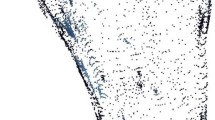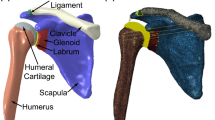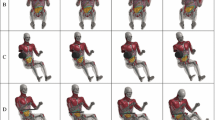Abstract
In previous shoulder impact studies, the 50th-percentile male GHBMC human body finite-element model was shown to have good biofidelity regarding impact force, but under-predicted shoulder deflection by 80% compared to those observed in the experiment. The goal of this study was to validate the response of the GHBMC M50 model by focusing on three-dimensional shoulder kinematics under a whole-body lateral impact condition. Five modifications, focused on material properties and modeling techniques, were introduced into the model and a supplementary sensitivity analysis was done to determine the influence of each modification to the biomechanical response of the body. The modified model predicted substantially improved shoulder response and peak shoulder deflection within 10% of the observed experimental data, and showed good correlation in the scapula kinematics on sagittal and transverse planes. The improvement in the biofidelity of the shoulder region was mainly due to the modifications of material properties of muscle, the acromioclavicular joint, and the attachment region between the pectoralis major and ribs. Predictions of rib fracture and chest deflection were also improved because of these modifications.







Similar content being viewed by others
References
Balaraman, K., S. Mukherjee, and A. Chawla. Soft tissue characterization for compressive loading using experiments and finite-element methods. SAE Technical Paper 06B-183, 2005.
Beillas, P., and F. Berthet. Performance of a 50th percentile abdominal model for impact: effect of size and mass. Eur. Soc. Biomech. Conf. 45:S83, 2012.
Best, T. M., J. McElhaney, W. E. Garrett, Jr, and B. S. Myers. Characterization of the passive responses of live skeletal muscle using the quasi-linear theory of viscoelasticity. J. Biomech. 27(4):413–419, 1994.
Crandall, J. R., D. Bose, J. Forman, C. D. Untaroiu, C. Arregui-Dalmases, C. G. Shaw, and J. R. Kerrigan. Human surrogates for injury biomechanics research. Clin. Anat. 24(3):362–371, 2011.
DeWit, J. A., and D. S. Cronin. Cervical spine segment finite-element model for traumatic injury prediction. J. Mech. Behav. Biomed. Mater. 10:138–150, 2012.
Donlon, J. P., D. Poulard, D. Lessley, P. Riley, and D. Subit. Understanding how scapula position and spine posture affect injury outcome in side impact sled tests using a new tool for visualization of PMHS kinematics. J. Biomech. 48(3):529–533, 2015.
Duprey, S., K. Bruyere, and J. P. Verriest. Human shoulder response to side impacts: a finite element study. Comput. Methods Biomech. Biomed. Eng. 10(5):361–370, 2007.
Eppinger, R., J. Marcus, and R. Morgan. Development of dummy and injury index for NHTSA’s thoracic side impact protection research program. SAE Technical Paper 840885, 1984.
Fice, J. B., D. S. Cronin, and M. B. Panzer. Cervical spine model to predict capsular ligament response in rear impact. Ann. Biomed. Eng. 39:2152–2162, 2011.
Fukuda, K., E. V. Craig, K. N. An, R. H. Cofield, and E. Y. Chao. Biomechanical study of the ligamentous system of the acromioclavicular joint. J. Bone Joint Surg. Am. 68(3):434–440, 1986.
Gennisson, J. L., T. Deffieux, E. Macé, G. Montaldo, M. Fink, and M. Tanter. Viscoelastic and anisotropic mechanical properties of in vivo muscle tissue assessed by supersonic shear imaging. Ultrasound Med. Biol. 36(5):789–801, 2010.
Huang, Y., A. I. King, and J. M. Cavanaugh. A MADYMO model of near-side human occupants in side impacts. J. Biomech. Eng. 116(2):228–235, 1994.
Iwamoto, M., K. Miki, M. Mohammad, A. Nayef, K. H. Yang, P. C. Begeman, and A. I. King. Development of a finite element model of the human shoulder. Stapp Car Crash J. 44:281–297, 2000.
Kemper, A. R., C. McNally, E. A. Kennedy, S. J. Manoogian, and S. M. Duma. The influence of arm position on thoracic response in side impacts. Stapp Car Crash J. 52:379–420, 2008.
Koh, S., J. M. Cavanaugh, and J. Zhu. Injury and response of the shoulder in lateral sled tests. Stapp Car Crash J. 45:101–141, 2001.
Lessley, D., G. Shaw, D. Parent, C. Arregui-Dalmases, M. Kindig, P. Riley, S. Purtsezov, et al. Whole-body response to pure lateral impact. Stapp Car Crash J. 54:289–336, 2010.
Li, Z., M. W. Kindig, J. R. Kerrigan, C. D. Untaroiu, D. Subit, J. R. Crandall, and R. W. Kent. Rib fractures under anterior-posterior dynamic loads: experimental and finite element study. J. Biomech. 43:228–234, 2010.
Li, Z., M. W. Kindig, D. Subit, and R. W. Kent. Influence of mesh density, cortical thickness and material properties on human rib fracture prediction. Med. Eng. Phys. 32:998–1008, 2010.
LS-DYNA Keyword User’s Manual, Version 971, Livermore Software Technology Corporation.
Mao, H., L. Zhang, B. Jiang, V.V. Genthikatti, X. Jin, F. Zhu, R. Makwana, A. Gill, G. Jandir, A. Singh and K.H. Yang. Recent advances in developing finite-element head model. International Crashworthiness Conference, Milan, 2012.
Muscolino, J. E. Know the Body: Muscle, Bone, and Palpation Essentials. Amsterdam: Elsevier BV, 2012, 154 pp.
Panjabi, M. M., T. R. Oxland, I. Yamamoto, and J. J. Crisco. Mechanical behavior of the human lumbar and lumbosacral spine as shown by three-dimensional load-displacement curves. J. Bone Joint Surg. Am. 76(3):413–424, 1994.
Park, G., T. Kim, J. R. Crandall, C. Arregui-Dalmases, and J. Luzon-Narro. Comparison of kinematics of GHBMC to PMHS on the side impact condition. In: 2013 IRCOBI Conference. Gothenburg, 2013.
Park, G., T. Kim, J. R. Crandall, A. Svendsen, N. Saunders, and C. Markusic. Comparison of GHBMC 50th percentile model response between FBM v3.5 and FBM v4.2 under lateral impact sled test condition. In: International Crashworthiness Conference 2014. Sarawak, 2014.
Poulard, D., D. Subit, J. P. Donlon, D. J. Lessley, T. Kim, G. Park, and R. W. Kent. The contribution of pre-impact spine posture on human body model response in whole-body side impact. Stapp Car Crash J. 58:385–422, 2014.
Shin, J., N. Yue, and C. D. Untaroiu. A finite-element model of the foot and ankle for automotive impact applications. Ann. Biomed. Eng. 40(12):2519–2531, 2012.
Society of Automotive Engineers. SAE Surface Vehicle Information Report: Sign Convention for Vehicle Crash Testing—SAE J1733. 1994.
Vavalle, N. A., M. L. Davis, J. D. Stitzel, and F. S. Gayzik. Quantitative validation of a human body finite-element model using rigid body impacts. Ann. Biomed. Eng. 43:2163–2174, 2015.
Vavalle, N. A., D. P. Moreno, A. C. Rhyne, J. D. Stitzel, and F. S. Gayzik. Lateral impact validation of a geometrically accurate full body finite-element model for blunt injury prediction. Ann. Biomed. Eng. 41:497–512, 2013.
Acknowledgments
The authors would like to thank Alayna Panzer, Ph.D, and Tim Gillispie for their thoughtful and thorough review of this manuscript.
Author information
Authors and Affiliations
Corresponding author
Additional information
Associate Editor Eiji Tanaka oversaw the review of this article.
Appendices
Appendix 1
See Figs. 8, 9, 10, 11, 12 and 13 and Tables 5 and 6.
Appendix 2: Modification on the Repositioned Model
First, the acromioclavicular (AC) joint of the repositioned model was changed from a fixed constraint to a ball joint between the clavicle and the acromion. The shoulder has a large range of motion, and it comes from the articulations in the shoulder: acromioclavicular, sternoclavicular, and glenohumeral joints. The AC joint is a planer type of synovial joint which articulates the distal end of the clavicle and the acromion of the scapula and is strengthened by ligaments: acromioclavicular and coracoclavicular ligaments (Fig. 14). In the GHBMC M50 model, the AC joint is modeled as the fixed constraint between the distal end of the clavicle and the acromion of the scapula. The coracoclavicular ligament is modeled separately using the shell elements in the GHBMC M50 model. In other words, a synovial joint with AC ligaments was assumed as the fixed joint in the model. In this study, the AC joint with AC ligament structure was assumed as the ball joint with free range of motion up to 45 [deg] for all three axis of rotation and the rotational stiffness of the joint beyond the free range of motion was assumed as 2222 [Nm/deg].
Second, the material properties of the muscles related to the shoulder of the GHBMC M50 model has been modified. The Muscles related to the shoulder play a key role in actuating and stabilizing the shoulder complex and consist of seventeen muscles (such as deltoid, trapezius, and pectoralis major) crossing the three joints of the shoulder.27 Those muscles in the GHBMC M50 model were depicted using three dimensional elements with isotropic viscoelastic material property. The material property was based on the data from the uniaxial tension of the rabbit tibialis anterior muscles along the fiber direction.3 This material property was probably the cause of an overestimation of the stiffness of muscles since the muscles have anisotropic properties. On the other hand, the material properties of the abdominal muscles in the GHBMC M50 model are based on the biomechanical test data using PMHS muscles in transverse direction compression.1 Thus, the material properties of muscles related to the shoulder in the GHBMC M50 model was changed to that of the abdominal muscles in the same model. The parts related to the shoulder which incorporated the changed muscle properties are listed in Table 6.
With the modified material properties of muscles related to the shoulder, the material properties of the adipose tissue and the flesh in the thorax was also modified. In the GHBMC M50 model, the thorax region was surrounded by the flesh and the adipose tissue fills up the space between the thoracic parts (Fig. 15). The flesh and adipose tissue use the same material properties and are likely to have a significant impact on shoulder response by constraining the relative motion of body parts. Due to the limited data on the material properties of adipose tissue applicable to the impact loading condition, these material properties were modified by the validation on the PMHS arm compression test conducted by Kemper et al. 14 (Figure 16). Kemper et al. compressed the forearm of the PMHS using the impactor at an initial speed of 2 and 4 m/s along the medial–lateral direction. The advantage of using that test data for this study was (1) the material property change of the muscle and adipose tissue could be validated since the arm contains adipose tissue as well as Biceps and Triceps muscles, (2) the impact speed was similar to the impact condition of this study, and (3) the loading direction was in the transverse direction, which is the same as this study. The response of PMHS 1 from Kemper’s study was selected as the reference data for the validation due to the similarity of arm dimension between the GHMBC model and the PMHS. Since the muscle material property was already changed using the abdominal muscle property of the model, the material property of the adipose tissue of the model modified to match the PMHS response. The validation results are shown in Fig. 17.
In addition to modifications related to the shoulder, the characteristics of the lumbar spine discs in the GHBMC M50 model were modified based on the reference data from Panjabi et al. 22 Panjabi loaded the lumbar spine for three directions of rotation and measured the rotation-moments curves of each lumbar disc (L1 to L5) which showed a nonlinear response. The lumbar spine disc in the GHBMC M50 model was modeled using the elastic beam element and its characteristic in each direction was assumed to be linear. Since the measure of shoulder deflection was the change of absolute distance from the T1 to the acromion, and the load wall used in this study had the 100[mm] pelvic offset, which induced severe deformation on the lumbar region, the characteristics of the lumbar discs could have had an effect on the shoulder response. As such, the characteristics of each lumbar disc along three directions of rotation were digitized from Panjabi’s study and incorporated into the GHBMC M50 model (Table 7).
Finally, the attachment region between the pectoralis major and the ribs in the GHBMC was modified. In the GHBMC M50 model the attachment region between the pectoralis major and the ribs was defined as the region from rib1 to rib6 as well as its intercostal cartilage (Fig. 18). On the other hand, Muscolino21 demonstrated that the origin of the pectoralis major is the medial clavicle, sternum, and the intercostal cartilages of ribs. Thus, the region of attachment between the pectoralis major and the ribs of the GHBMC M50 model was reduced to match the region claimed by Muscolino (Fig. 18).
Rights and permissions
About this article
Cite this article
Park, G., Kim, T., Panzer, M.B. et al. Validation of Shoulder Response of Human Body Finite-Element Model (GHBMC) Under Whole Body Lateral Impact Condition. Ann Biomed Eng 44, 2558–2576 (2016). https://doi.org/10.1007/s10439-015-1546-6
Received:
Accepted:
Published:
Issue Date:
DOI: https://doi.org/10.1007/s10439-015-1546-6















